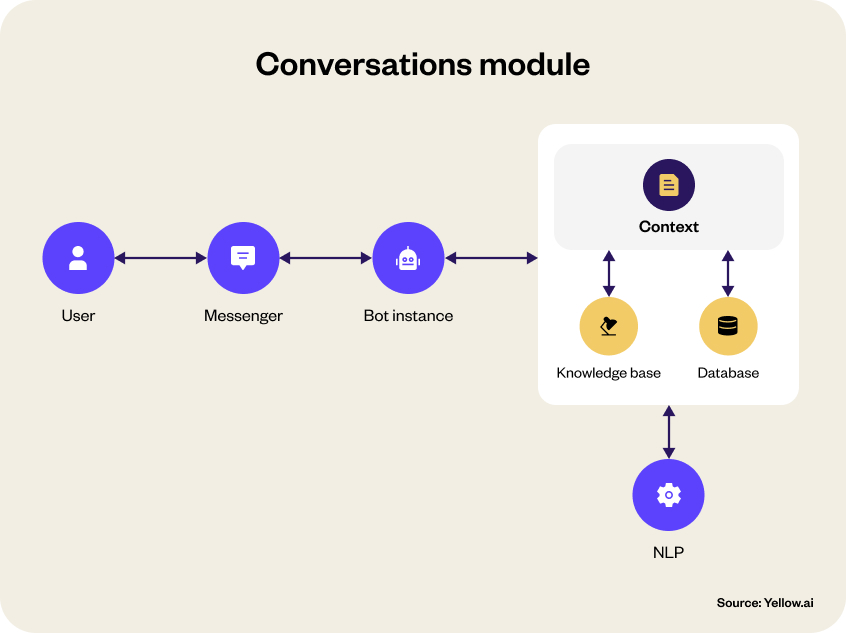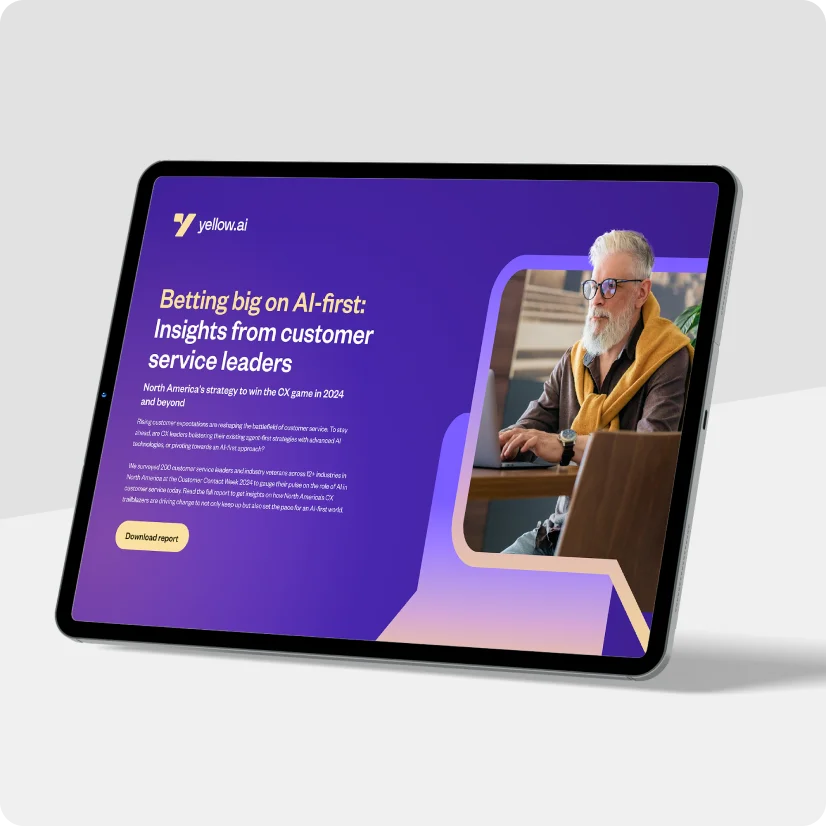We’re well-past the days when callers had to navigate IVRs by tediously listening to menus and pressing corresponding numbers on their keypads. Intelligent voice bots that understand and respond to natural language have revolutionized the way customers interact with your brand. In this blog we’ll explore what voice bots are and how different industries can use them to enhance their total user experience?
What is a voice bot?
A voice bot is an AI-powered software that synthesizes speech to converse with users by understanding natural language (NLU). Voice bots enable customers to have a more open-ended conversation instead of struggling with a myriad of traditional IVR options.
Receive policy details


Get consultation


Claim insurance


Voice bots have been here for the longest time, but the recent advancements in the fields of AI, machine learning, NLP and NLU have made them more sophisticated. The wide adoption of smart voice assistants, such as Alexa, Google Home, and Siri has encouraged brands globally to invest in voice bots that offer an intelligent, natural, and intuitive human-machine interaction.
How do voice bots work?
The operational flow of an AI-powered voice bot includes the following steps:

1. Automatic speech recognition (ASR)
ASR enables the bot to understand human voice inputs, filter out the background noise, use speech to text to deduct the query and simulate a human-like response. There are two types of ASR softwares – Directed dialogue and natural language conversations.
Directed dialogue is a simpler version of ASR that is capable of answering basic yes/no questions. Whereas, natural language conversations are more complex and improved versions of ASR that simulate actual human conversations.
2. Natural language Understanding (NLU)
NLU is a component of ASR that empowers the bot to analyze incoming queries to understand what a particular group of words mean and then classifying it into proper intents. NLU works on either one of these two mechanisms – Human tuning or active learning.
Human tuning is a manual process which involves adding commonly used phrases to the conversation logs. It is done to expand the comprehension of speech so that the bot can understand new questions without a problem.
Active learning, on the other hand, is a more advanced version of NLU that self-learns and expands its vocabulary by learning from its previous conversations. This software has the ability to understand user intent and behavior to deliver a more personalized response.
3. Conversations Module
This module focuses on matching the user’s query with millions of pieces of underlying information, also known as a knowledge base. When the voice bot finds a piece of information that’s most relevant to the query, it then forms a suitable response using text to speech.
Knowledge bases enable the voice assistant to generate custom responses. For instance, when you ask your Google assistant to call your friend John, it will use your contact list as a database to find the name John and place a call. With time, the assistant’s knowledge base increases and it becomes more intelligent.

4. Text-to-speech (TTS)
To reply to customers’ query, voice bots can either use pre-recorded audio files or the Text-to-Speech (TTS) technology. It is a computer-generated simulation of human speech, also known as speech synthesis that uses deep learning methods to give natural-sounding replies.
Industry-wise use cases of AI voice chatbot
1. Voice chatbot in healthcare
Voice bots played a major role in spreading awareness about safety and prevention protocols, during the fight against covid-19. Even today, the government is using outbound calls to remind people about getting vaccinated and staying indoors for their safety.
Voice and conversational AI also made health services more accessible to everyone as patients were able to book tests, appointments and schedule calls with the doctors without having to visit the hospital.
Now that people have a taste for what is possible with voice and healthcare, they are only going to expect more from the healthcare companies. It is expected that more investment will be made to integrate voice AI in the healthcare industry in the years to come.
2. Voice bots in banking
Voice bots in the banking and finance sector have made it possible for customers to get on-demand services. Most banking contact centers engage with customers through tedious IVR systems.
Callers have to listen to a series of prompts where they need to type a specific number on the keypad to go to the next option. 88% of users who reach an IVR end up speaking to a live agent to resolve their issue. This can increase the workload of agents and longer wait times for customers.

This is why intelligent voice bots can be used to converse with customers to solve their problems just like a human agent would. This not only maximizes employee efficiency and reduces operational costs, but also reduces delays of more than 5 minutes.Following are the use cases of voice bots for the banking sector.
- Provide Personalized tips to customers to manage their finances better.
- Help customers block a lost card or issue a new one.
- Inform customers about credit card offers, payment deadlines, new policies etc.
- Help customers choose the best financial products for them.
- Answer customer queries about certain products or services.
- Reduce the risk of fraud by identifying fraudulent activities.
3. Role of voice bots in the retail and E-commerce sector
The most popular application of voice bots is in the online retail and E-commerce sector. Customers can easily connect with a brand over call and perform tasks like cancel a product, initiate returns, request refunds, gain product information, and so much more. Using voice bots can enable customers to self-serve their queries. This will save agents’ time and allow them to focus on more pressing customer problems.
Voice automation can also supercharge sales and revenue for E-commerce companies. Voice bots can be used to remind customers about abandoned carts, promote new products, inform them about limited-time offers and collect their feedback. Sky’s the limit really for what you can achieve with E-commerce voicebots.

4. Voice bots in call centers
The covid-19 outbreak caused a major shift in consumer behavior as more and more people shifted online to meet their daily needs. This led to a drastic increase in customer engagement. Hiring more agents to meet the increased number of customer queries can put a huge strain on the OpEx of a company. This is where voice bots play a huge role.
Voice bots can automate repetitive tasks and handle a major volume of queries single-handedly. Their Accuracy, speed, and 24*7 availability improves Call Center response rates. It also leads to an increase in customer satisfaction and turns them into loyal brand advocates.
5. Voice bots in gaming
Voice-activated chatbots will play a crucial role in the gaming industry. It is changing the way gamers interact with a game and the content inside it. It will take the gaming experience up a notch by making it more realistic.
One of the most straightforward applications of voice bots in gaming is using them to instill in-game actions. With built-in voice recognition, voice bots will be able to take voice commands from gamers and perform simple or complex actions. Also, integrating them with VR headsets can make the experience all the more immersive. This right here is the beginning of the metaverse!
6. Voice bots in HR
AI voice bots in HR are assisting in recruiting, onboarding, answering day-to-day queries and saving the time spent by HR on mundane tasks. By deflecting all the time-consuming tasks to the voice bot, the HR team can have much more free time for productive tasks such as employee engagement and retention. Here are a few tasks that voice bots can handle for the HR team,
- Schedule interviews and gather candidate details
- Notify applicants about interview procedures and significant dates
- Act as a knowledge base for new employees
- Automating repetitive and time-consuming tasks
What are the best practices of implementing a voice bot
1. Your voice bot should be as robust as your chatbot
Even though voice is an alternative way of communication, it shouldn’t be less capable than a text-based bot.
2. Humanize your voice bot with a persona
Customers prefer to have a human touch in customer support. To make your voice chatbot more human, you can give it a name, gender, voice and personality.
3. Program your voice bot to listen and remember
Your voice bot should not only remember the main topic of the call but also listen and remember the important details shared by customers.
4. Voice bots should know when to transfer to a live agent
Voice bots help customers self-serve but they should not block people from speaking to live agents, if required.
To sum up
Companies around the world are increasingly integrating their existing IVR and PBX systems with sophisticated voice bots. The reason being, voice bots use the most natural form of communication i.e. speech. Voice assistants such as Alexa, Siri, Google Assistant and Cortana are already an integral part of everybody’s lives. This is why customers prefer to use voice bots to resolve their queries on-the-go and expect brands to introduce voice channels.
With Yellow.ai, building a chatbot is as easy as it gets. You can create a chatbot on our no-code chatbot building platform and deploy it to 35+ channels, including voice, with a single click. Request a demo and our experts will help you get started!
























